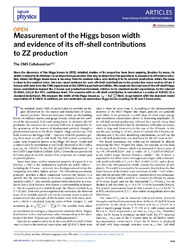Measurement of the Higgs boson width and evidence of its off-shell contributions to ZZ production
| dc.contributor.author | Tumasyan, A. | |
| dc.contributor.author | Işıldak, Bora | |
| dc.date.accessioned | 2023-06-12T12:54:41Z | |
| dc.date.available | 2023-06-12T12:54:41Z | |
| dc.date.issued | 2022-11 | |
| dc.identifier.issn | 1745-2473 | en_US |
| dc.identifier.uri | http://hdl.handle.net/10679/8376 | |
| dc.identifier.uri | https://www.nature.com/articles/s41567-022-01682-0 | |
| dc.description.abstract | Since the discovery of the Higgs boson in 2012, detailed studies of its properties have been ongoing. Besides its mass, its width—related to its lifetime—is an important parameter. One way to determine this quantity is to measure its off-shell production, where the Higgs boson mass is far away from its nominal value, and relating it to its on-shell production, where the mass is close to the nominal value. Here we report evidence for such off-shell contributions to the production cross-section of two Z bosons with data from the CMS experiment at the CERN Large Hadron Collider. We constrain the total rate of the off-shell Higgs boson contribution beyond the Z boson pair production threshold, relative to its standard model expectation, to the interval [0.0061, 2.0] at the 95% confidence level. The scenario with no off-shell contribution is excluded at a p-value of 0.0003 (3.6 standard deviations). We measure the width of the Higgs boson as ΓH=3.2−1.7+2.4MeV, in agreement with the standard model expectation of 4.1 MeV. In addition, we set constraints on anomalous Higgs boson couplings to W and Z boson pairs. | en_US |
| dc.description.sponsorship | BMBWF and FWF (Austria); FNRS and FWO (Belgium); CNPq, CAPES, FAPERJ, FAPERGS and FAPESP (Brazil); MES and BNSF (Bulgaria); CERN; CAS, MoST and NSFC (China); MINCIENCIAS (Colombia); MSES and CSF (Croatia); RIF (Cyprus); SENESCYT (Ecuador); MoER, ERC PUT and ERDF (Estonia); Academy of Finland, MEC and HIP (Finland); CEA and CNRS/IN2P3 (France); BMBF, DFG and HGF (Germany); GSRI (Greece); NKFIA (Hungary); DAE and DST (India); IPM (Iran); SFI (Ireland); INFN (Italy); MSIP and NRF (Republic of Korea); MES (Latvia); LAS (Lithuania); MOE and UM (Malaysia); BUAP, CINVESTAV, CONACYT, LNS, SEP and UASLP-FAI (Mexico); MOS (Montenegro); MBIE (New Zealand); PAEC (Pakistan); MSHE and NSC (Poland); FCT (Portugal); JINR (Dubna); MON, RosAtom, RAS, RFBR and NRC KI (Russia); MESTD (Serbia); MCIN/AEI and PCTI (Spain); MOSTR (Sri Lanka); Swiss Funding Agencies (Switzerland); MST (Taipei); ThEPCenter, IPST, STAR and NSTDA (Thailand); TUBITAK and TAEK (Turkey); NASU (Ukraine); STFC (United Kingdom); DOE and NSF (United States). Individuals have received support from the Marie-Curie programme and the European Research Council and Horizon 2020 Grant under contracts nos. 675440, 724704, 752730, 758316, 765710, 824093, 884104 and COST Action CA16108 (European Union); the Leventis Foundation; the Alfred P. Sloan Foundation; the Alexander von Humboldt Foundation; the Belgian Federal Science Policy Office; the Fonds pour la Formation a la Recherche dans l'Industrie et dans l'Agriculture (FRIA-Belgium); the Agentschap voor Innovatie door Wetenschap en Technologie (IWT-Belgium); the F.R.S.-FNRS and FWO (Belgium) under the `Excellence of Science-EOS' -be.h project no. 30820817; the Beijing Municipal Science & Technology Commission, no. Z191100007219010; the Ministry of Education, Youth and Sports (MEYS) of the Czech Republic; the Deutsche Forschungsgemeinschaft (DFG), under Germany's Excellence Strategy-EXC 2121 `Quantum Universe'-390833306, and under project no. 400140256-GRK2497; the Lendulet (`Momentum') Program and the Janos Bolyai Research Scholarship of the Hungarian Academy of Sciences, the New National Excellence Program UNKP, NKFIA research grants 123842, 123959, 124845, 124850, 125105, 128713, 128786 and 129058 (Hungary); the Council of Science and Industrial Research (India); the Latvian Council of Science; the Ministry of Science and Higher Education and the National Science Center, contracts Opus 2014/15/B/ST2/03998 and 2015/19/B/ST2/02861 (Poland); the Fundacao para a Ciencia e a Tecnologia, grant no. CEECIND/01334/2018 (Portugal); the National Priorities Research Program by Qatar National Research Fund; the Ministry of Science and Higher Education (projects nos. 0723-2020-0041 and FSWW-20200008) (Russia); MCIN/AEI/10.13039/501100011033, ERDF `a way of making Europe', and the Programa Estatal de Fomento de la Investigacion Cientifica y Tecnica de Excelencia Maria de Maeztu, grant no. MDM-2017-0765 and Programa Severo Ochoa del Principado de Asturias (Spain); the Stavros Niarchos Foundation (Greece); the Rachadapisek Sompot Fund for Postdoctoral Fellowship, Chulalongkorn University and the Chulalongkorn Academic into Its 2nd Century Project Advancement Project (Thailand); the Kavli Foundation; the Nvidia Corporation; the SuperMicro Corporation; the Welch Foundation, contract no. C-1845; and the Weston Havens Foundation (United States). | |
| dc.language.iso | eng | en_US |
| dc.publisher | Nature Research | en_US |
| dc.relation.ispartof | Nature Physics | |
| dc.relation.ispartof | Article - International Refereed Journal - Institutional Academic Staff | |
| dc.rights | openAccess | |
| dc.rights.uri | https://creativecommons.org/licenses/by/4.0/ | |
| dc.title | Measurement of the Higgs boson width and evidence of its off-shell contributions to ZZ production | en_US |
| dc.type | Article | en_US |
| dc.description.version | Publisher version | en_US |
| dc.peerreviewed | yes | en_US |
| dc.publicationstatus | Published | en_US |
| dc.contributor.department | Özyeğin University | |
| dc.contributor.authorID | (ORCID 0000-0002-0283-5234 & YÖK ID 124605) Işıldak, Bora | |
| dc.contributor.ozuauthor | Işıldak, Bora | |
| dc.creator | The CMS Collaboration | |
| dc.identifier.volume | 18 | en_US |
| dc.identifier.issue | 11 | en_US |
| dc.identifier.startpage | 1329 | en_US |
| dc.identifier.endpage | 1334 | en_US |
| dc.identifier.wos | WOS:000870649900005 | |
| dc.identifier.doi | 10.1038/s41567-022-01682-0 | en_US |
| dc.identifier.scopus | SCOPUS:2-s2.0-85140310896 |
Files in this item
This item appears in the following Collection(s)
Share this page




